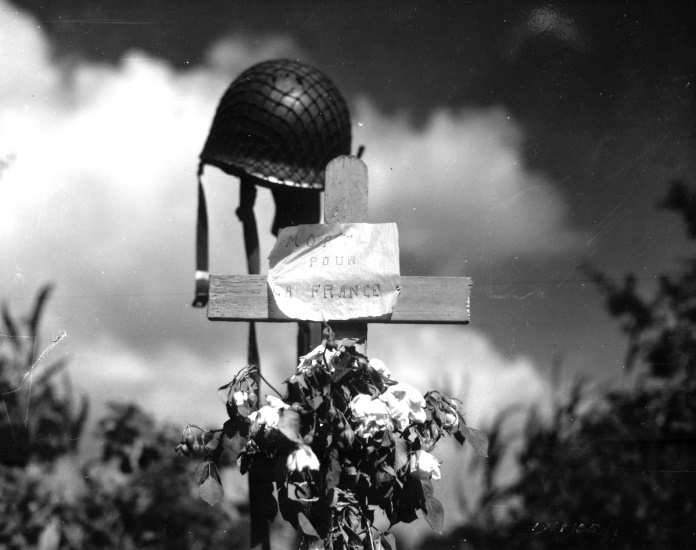Col Sink was contacted by radio and the situation was explained to him. He directed the 1/506 to seize St Come du Mont, and the 1/501 to seize the crossroad. In the half-hour that this conference had consumed, most of the troops had taken what cover they could and had fallen asleep. Others, uncomfortable under the heavy mortar fire, had moved forward to avoid it. Troop leaders had become casualties and virtually all control was lost. Thus, when the order to attack the town was given, there were few troops available to execute the mission. The battalion adjutant and the S-3 rounded up the few Hqs Co men that could be found, and this force of about ten men attacked the town along the road west, under the direction of the adjutant. The S-3 endeavored to find more of the battalion and finally located part of a platoon of Dog Co. This unit attacked from the north on the east side of the main highway. Both of these attacks were stopped by the enemy at the edge of the town. About twenty men from Able and Charlie Cos had gone forward while the battalion commanders were determining who was to seize the crossroad. They moved to a position on top of a cut along the highway from which they could cover the crossroad by fire and stretched out to sleep.
The remainder of the battalion, according to reports of officers that night, was either asleep or drowsily waiting for the attack to advance. A part of Dog Co had gone on down to the objective prior to the time that the rest of the battalion had halted. This element, finding itself over-extended, returned to the crossroad about 1000 and occupied German-prepared positions. The two units attacking the town spent most of the day exchanging a few shots with enemy soldiers in the town but made no aggressive effort to continue the attack until 1600 when a patrol returned and reported the town to be empty. The situation was a little better in the 501-PIR. Part of it had eventually gone forward past the objective and had then returned to it when 88-MM fire from the south made their more exposed forward position untenable. There are at least two views of the enemy action that day; The one taken by Lt Col Charles H Chase, the Regimental Executive Officer, that the enemy resistance encountered in and around St Come du Mont was a high-powered delaying action; and the view was taken by this writer, although neither can be proven.
The first element of the battalion to engage in a firefight was the mixed group from Able and Charlie Cos shortly after 0800 when it had taken position along with the highway cut. This action was with what appeared to be a patrol moving south out of the town. In the ensuing firefight, each side incurred one casualty. The patrol withdrew and no further enemy activity was noted in the south of town. The second encounter was about 0900 when the adjutant’s group attacked the east side of the town and was held off. The third encounter was shortly after 0900 when the Dog Co force attacked and was pushed back. The fourth contact was at about 1000 when the Able and Charlie Co group, and the elements of the 501 near the crossroad, were attacked by a small force from the west. This attack was driven off, and another, in greater strength, was launched immediately. The apparent objective of the attack was the high ground overlooking the cut. This attack was also stopped, but with a loss of about half of the Able and Charlie Co men. They were on the exposed ground and had no entrenching tools to make any kind of cover. Further, the ground to the rear was so exposed that retreat was impossible, and the safest tactics appeared to be the continuous employment of every weapon available.
These attacks continued until nearly noon, when the enemy executed a flanking maneuver around the right flank and seized the hill, driving the eight or ten remaining men back to the road on the east. At precisely this moment, reinforcement in the form of three light tanks arrived from the direction of
Beaumont and was immediately committed front ally toward the cut. About twenty men from the 501 and the Able and Charlie Co forces, taking cover in the rear of the tanks, advanced and recaptured their previous position. The presence of the tanks put an entirely different light on the situation, apparently, for the enemy promptly withdrew to the west.
Seizure of the crossroad, and the clearing of the enemy from the beachhead area, completed the initial mission of the 101-A/B. At about 1800, the battalion was assembled east of St Come du Mont and reverted to regimental reserve. The following day, an abandoned supply train was found with its head at the objective crossroad and extending back along the road to the west. This train was horse-drawn and consisted of about fifty wagons with various supplies, a few artillery pieces, and kitchen wagons with utensils, containing food, still warm. Whether or not this train belonged to a unit emplaced to execute a delaying action, or to a unit that was attempting to fight its way southward through St Come du Mont to Carentan, was never determined. The question is of importance now only in considering the doctrine of defense against airborne troops. The Normandy campaign clearly indicated that the German defense against airborne attacks was not tactically sound.





















